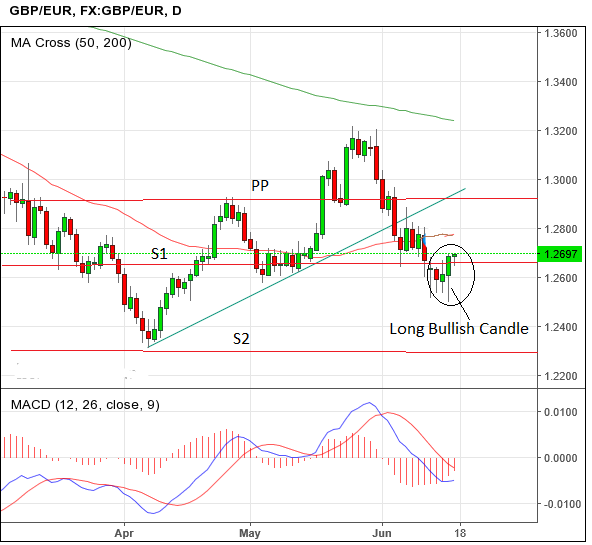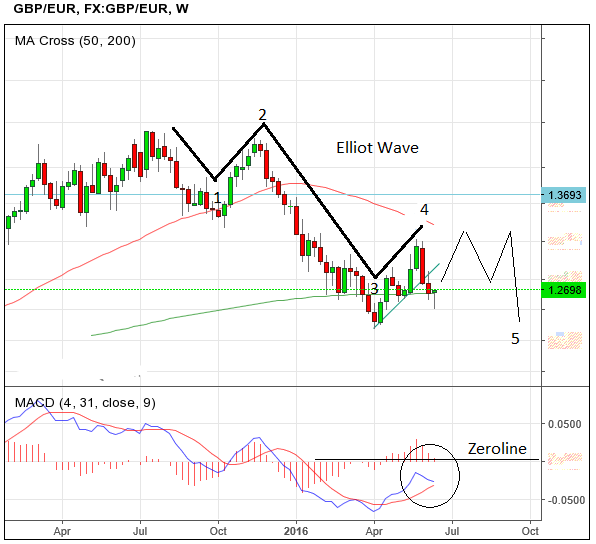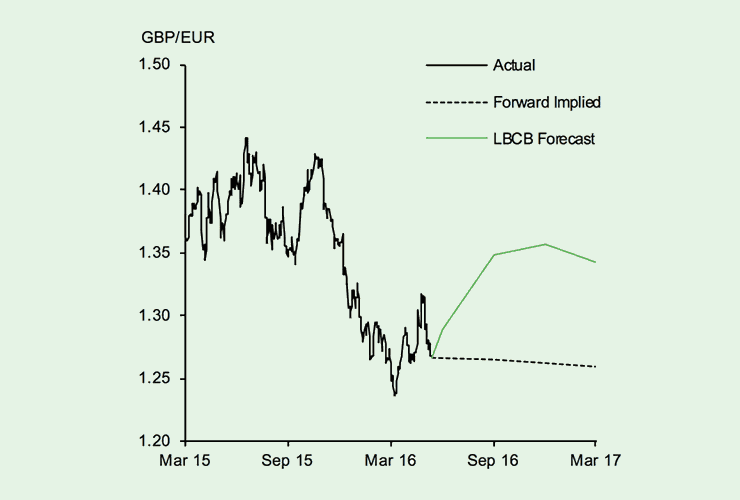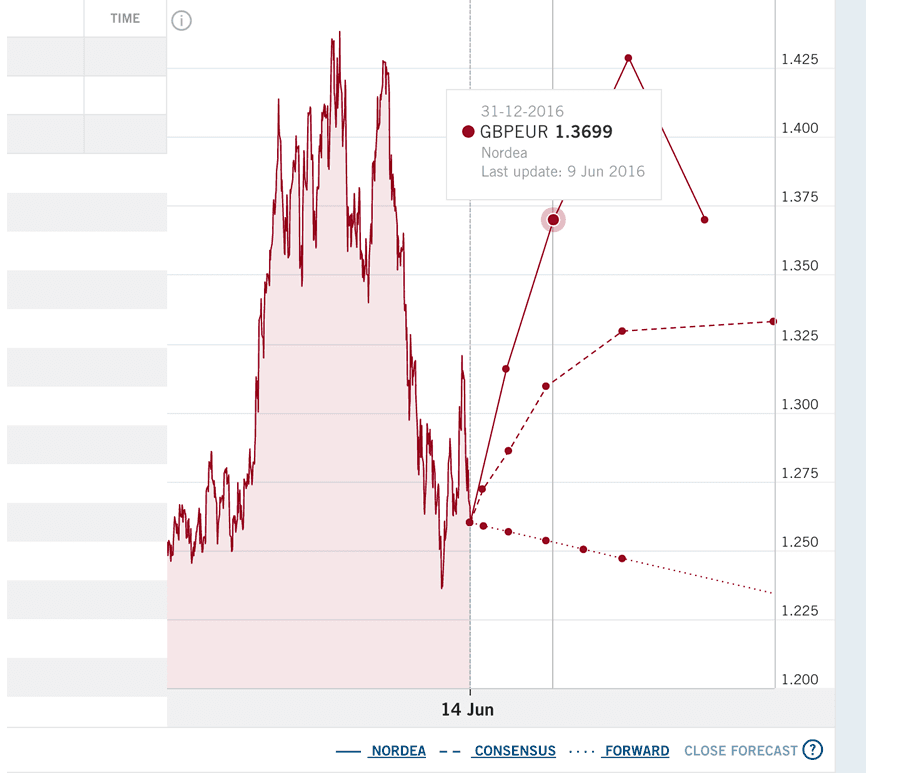Lloyds and Nordea Forecast Pound / Euro Above 1.35 by Start of 2017

A long bullish candle formed on GBP/EUR at the close of the week 13-17 June, and this may be the first sign of a broader recovery envisaged by analysts at Lloyds and Nordea Bank.
The longer-than-average bullish day's range which formed on Thursday the 16th, followed by a strong close on Friday the 17th June, could be a first sign that the tide may be changing for the pound.
Sterling has taken a hammering over recent weeks as the lead for the 'Remain' campaign has shrunken to a hair's breadth.
Days which have long ranges and close towards their highs are especially strong technical signals of more upside to come, although their forecast horizon is not long-term. Nevertheless, they can mark the beginnings of medium term trends.

This bullish outlook falls in line with research from Lloyds Commercial Banking and Nordea, which has pointed to the probability of further upside in the exchange rate over the next 3-6-month horizon.
Another technical sign there could be more upside comes from viewing the move down from the 1.44 highs in July last year as a type of pattern called an Elliot Wave.
Without wanting to get too technical, such an analysis would suggest the move up from the 1.23 April lows had not completed - at least in time.
It will only have completed after the MACD - on a special 4,31 setting used to analyse Elliot Waves - has moved above the zero line - which is has not yet done.
This analysis would suggest the possibility of the next move being up, to retouch the 1.32 May highs.

Lloyds Forecast GBP/EUR Reaching 1.30 After the Referendum
Lloyds have told clients they are maintaining their call for the pound to edge above 1.30, after the referendum and over coming months and potentially trade above 1.35 in 2017.
If they are right it suggests those with big euro payments should wait for the furore around the referendum to settle down before making their transfers.
In the latest edition of their International Financial Outlook publication, Lloyds confirm the trajectory for GBP/EUR is higher:

“By convention, all of our forecasts are based on the assumption that UK government policy towards EU membership remains unchanged,” say Lloyds. “Under this premise, we look for GBP/EUR to end the year around 1.36.”
Sweden's Nordea Bank AB are in agreement with their counterparts at Lloyds and confirm sterling will end the year higher against the euro.
The following chart from Nordea echoes the trajectory assumed by Lloyds Bank but there is an extra line on this graph - and that is the consensus forecast:

As can be see, consensus estimates from all the major institutions forecast the pound to trade at 1.3095 in December.
However, Nordea themselves are more bullish and hold a GBP/EUR forecast at 1.3699 for the start of 2017.
Aurelija Augulyte, a researcher at Nordea, says the GBP has room to gain on a positive outcome to the referendum.
Like Lloyds, and the other major institutions, the positive outcome being referred to here is a Remain victory.
Augulyte is more bullish than consensus largely because she believes her peers are too pessimistic in pricing in a pro-GBP interest rate rise at the Bank of England.
“It is still rather far into the future. It is historically the norm that the BoE follows the Fed within six months with the first hike. Should history rhyme, they are well behind and further repricing will happen as risk appetite improves,” says Augulyte.
Augulyte says that even if the GBP remains constant, inflationary pressures arise from the labour market.
(Typically a stronger pound has a dampening effect on inflation as it keeps imports cheaper. The UK is an import economy).
If the Bank of England gauges that inflation is rising at a speed that endangers their mandate, they could well rush forward GBP-positive interest rate rises.
With regards to the employment market, the output gap is nearly closed and this supports further wage growth and thus inflationary pressures.
The output gap, or what the Bank likes to call ‘slack’, is refers to the phenomenon whereby employment is growing but wages are static. It suggests workers are not yet working to their full potential and therefore do not have the power to command higher wages.
Now that the economy is running close to full employment, workers will become more productive and command higher pay packets.
This is held to be inflationary as there will be more money in the economy chasing fewer goods.
Indeed, the data released on the 15th of June will only solidify this assessment - it was shown by the ONS that wages are growing well ahead of expectation, something that has afforded the GBP a little short-term relief.
“The strong labour market is reflected in moderating but still solid consumption. While most major economies are saving, UK households are dissaving at the highest ever rate (2% of GDP over the past year),” says Augulyte.
Further evidence of a positive outlook for sterling lies with the housing market.
“Prices are well correlated with the GBP,” says Augulyte, “the housing market has held up well so far despite global turmoil and indicators suggest at least stable growth near term.
“This implies the GBP move down is overdone.”
A Lower Euro, Whatever the Outcome of the EU Vote?
Both Lloyds and Nordea have based their forecasts on the assumption the UK will vote to stay within the euro.
But, what is interesting is that the pound could end higher against the euro even in the event of Brexit.
Typical thinking goes that the pound will fall against all currencies on the event of a Leave vote, the euro included.
But this could be where people will get a big surprise.
We have heard more and more analysts suggest that the euro will be the big loser of an UK exit as it will shake the very existence of the Eurozone to the core.
"The euro is very likely the currency that in the longer term will be most affected by the UK vote, second only to the pound. The euro will be weak in the event of a Brexit," says Lars Henriksson, FX Strategist at Handelsbanken.
Similarly, the euro will strengthen in a relief rally if the British decide to stay in the EU, but problems are piling up inside the eurozone and more countries are questioning membership.
"We find it hard to see the euro as a winner beyond one month after the vote, regardless of the outcome," says Henriksson.
The most-read piece on Pound Sterling Live at present is coverage of the views presented by NAB's Nick Parsons who says the pound could fall to 1.20 and then bounce back to 1.40 "within days" of an Out vote.




